THE DOGRUN
a place to share ideas
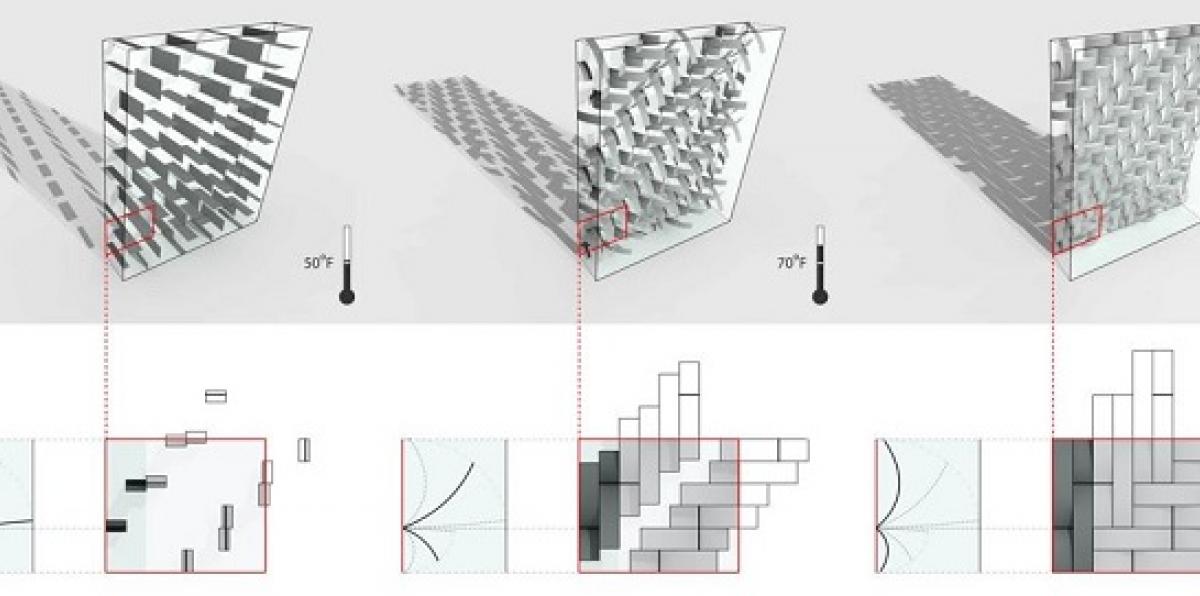

Lake Flato R&D: Passive Solar Tracking
Posted by AHeisserer on 6/21/17 at 3:33 pm
Lake Flato recently established a research and development program with the goal of providing a framework to promote innovative thinking in the integration of design and sustainability. This is the first in a series of posts documenting the initial round of research projects in the Fall of 2016. My challenge was this: to develop a system that rotates to face the sun throughout the day using nothing but solar heat energy from the sun itself, and no technical equipment.
Considerations included preventing unwanted heat gain, and maximizing usable daylight while maintaining views straight out of the window. And finally, it had to be made with affordable and easily available materials. If I couldn’t make it with cheap bulk materials from Home Depot, and put together in the Lake Flato Shop, then the technology isn’t simple and affordable enough to be ubiquitous and scalable. Why Passive Solar Tracking? Why chose to improve on solar power in the first place? This is our electric grid today. It’s becoming too expensive to maintain, it runs mostly on non-renewable sources, and it’s being slowly replaced by on-site solar power. Solar is getting cheaper, the equipment is far cheaper than the cost of installation, and photovoltaics technologies are slowly getting more efficient every year. If you were to track the sun perfectly throughout the day, you can increase total power by 25 to 33%. That’s a huge margin of improvement, considering the incremental improvements in PV efficiency are just a few percentage points every few years. But while tracking is beneficial, a high degree of precision is not. A perfectly aligned systems collects 100% of the potential power, 15 degrees of misalignment still gathers 97%, and a full 30 degrees of misalignment still gets 90%. A solar tracker does not need to be perfect, but needs to rotate just enough to capture most of the benefits of alignment.
Existing Systems
Why chose to improve on solar power in the first place? This is our electric grid today. It’s becoming too expensive to maintain, it runs mostly on non-renewable sources, and it’s being slowly replaced by on-site solar power. Solar is getting cheaper, the equipment is far cheaper than the cost of installation, and photovoltaics technologies are slowly getting more efficient every year. If you were to track the sun perfectly throughout the day, you can increase total power by 25 to 33%. That’s a huge margin of improvement, considering the incremental improvements in PV efficiency are just a few percentage points every few years. But while tracking is beneficial, a high degree of precision is not. A perfectly aligned systems collects 100% of the potential power, 15 degrees of misalignment still gathers 97%, and a full 30 degrees of misalignment still gets 90%. A solar tracker does not need to be perfect, but needs to rotate just enough to capture most of the benefits of alignment.
Existing Systems
 There are already passive sun tracking systems that exist today, such as these systems by Dennis Burkholder and Zomeworks Corporation. Almost all of them use liquid Freon or some other highly responsive, volatile liquid to change the center of gravity of the array and shift it towards the sun throughout the day. The problem is that these systems are generally about 25-30% more expensive than static systems and the benefits of tracking are outweighed by their added cost. Even if solar power becomes dirt cheap and maximizing every bit of solar power is not necessary, we will always need natural solutions for improving the qualities of interior spaces.
There are already passive sun tracking systems that exist today, such as these systems by Dennis Burkholder and Zomeworks Corporation. Almost all of them use liquid Freon or some other highly responsive, volatile liquid to change the center of gravity of the array and shift it towards the sun throughout the day. The problem is that these systems are generally about 25-30% more expensive than static systems and the benefits of tracking are outweighed by their added cost. Even if solar power becomes dirt cheap and maximizing every bit of solar power is not necessary, we will always need natural solutions for improving the qualities of interior spaces.
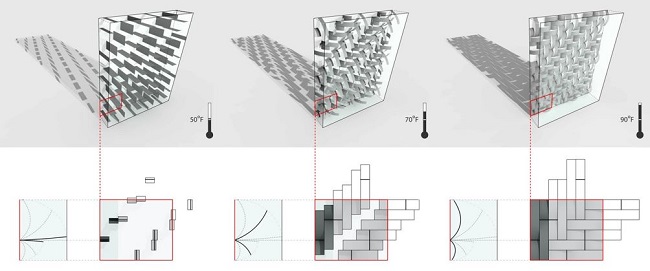 There are some systems being developed for an architectural shading application such as these prototypes by DOSU Studio Architecture. These leverage the reactivity of thermal bimetal, a composite of two metals that bend when heated, and fold over to obstruct the window during times of high solar heat gain. The question that arises from this is, why have a window if it's going to be completely opaque at certain times and lose all visual transparency? A binary compromise is not ideal for controlling something as dynamic as heat and daylight.
There are some systems being developed for an architectural shading application such as these prototypes by DOSU Studio Architecture. These leverage the reactivity of thermal bimetal, a composite of two metals that bend when heated, and fold over to obstruct the window during times of high solar heat gain. The question that arises from this is, why have a window if it's going to be completely opaque at certain times and lose all visual transparency? A binary compromise is not ideal for controlling something as dynamic as heat and daylight.
 To address this challenge, while working at the Digital Architecture Research Consortium at UT Arlington with Professor Brad Bell, Khang Nguyen, Tenaj Pinder, and Alexei Dukov, our team developed a bimetal facade system that remains aligned and allows more light in when it’s cold, and then folds over to keep the overhead sun out when it’s hot, while always maintaining visibility straight out of the window.
To address this challenge, while working at the Digital Architecture Research Consortium at UT Arlington with Professor Brad Bell, Khang Nguyen, Tenaj Pinder, and Alexei Dukov, our team developed a bimetal facade system that remains aligned and allows more light in when it’s cold, and then folds over to keep the overhead sun out when it’s hot, while always maintaining visibility straight out of the window.
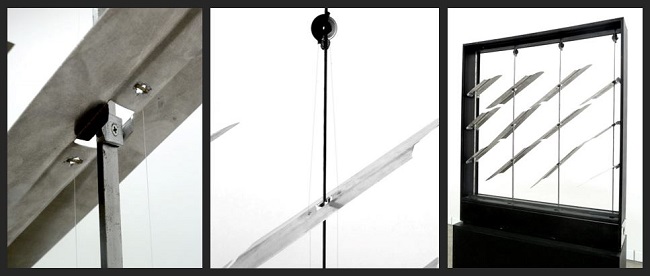 Later we moved from using a bimetal surface as the active component to using a bimetal coil to rotate a flat aluminum surface in order to improve the rotational ability of the system. It was rather difficult to calibrate the rotation of coil to the rotation of the aluminum fins, and nearly impossible to keep all the aluminum fins aligned. My goal now is to achieve true solar tracking, not just open/close compromises, or vertical/horizontal compromises, but true rotation that responds directly to the position of the sun. At the start of the research term last fall, I re-explored a few different options to make this system truly responsive, reliable, and affordable.
Heat Engine Typologies
Later we moved from using a bimetal surface as the active component to using a bimetal coil to rotate a flat aluminum surface in order to improve the rotational ability of the system. It was rather difficult to calibrate the rotation of coil to the rotation of the aluminum fins, and nearly impossible to keep all the aluminum fins aligned. My goal now is to achieve true solar tracking, not just open/close compromises, or vertical/horizontal compromises, but true rotation that responds directly to the position of the sun. At the start of the research term last fall, I re-explored a few different options to make this system truly responsive, reliable, and affordable.
Heat Engine Typologies
 Simple ambient heat engines have been understood and utilized for centuries, but never considered as viable sources of energy generation because of their low energy-to-work potential. Rather than being dismissed as novelties, heat engines can be put to work calibrating photovoltaic systems, greatly increasing their efficiency.
The first heat engine typology I considered was to use heat-responsive volatile liquids that vaporize or condense, and cause an imbalance in a system. This is the same concept used in the classic drinking bird heat engine toy: the lower end of the glass container is warmer than the birds head above, so the methylene chloride inside expands upward, tilts the bird’s head into the water which cools the head and causes the cycle to continue. Naturally, I bought a drinking bird and dissected it. Poor thing. Unfortunately, you need the liquid to be in a vacuum sealed tube which is not easy to make or maintain, and even then, methylene chloride isn’t an ideal chemical to be handling and building into a prototype. And there are no good chemical alternatives that are both heat-responsive enough and innocuous.
Simple ambient heat engines have been understood and utilized for centuries, but never considered as viable sources of energy generation because of their low energy-to-work potential. Rather than being dismissed as novelties, heat engines can be put to work calibrating photovoltaic systems, greatly increasing their efficiency.
The first heat engine typology I considered was to use heat-responsive volatile liquids that vaporize or condense, and cause an imbalance in a system. This is the same concept used in the classic drinking bird heat engine toy: the lower end of the glass container is warmer than the birds head above, so the methylene chloride inside expands upward, tilts the bird’s head into the water which cools the head and causes the cycle to continue. Naturally, I bought a drinking bird and dissected it. Poor thing. Unfortunately, you need the liquid to be in a vacuum sealed tube which is not easy to make or maintain, and even then, methylene chloride isn’t an ideal chemical to be handling and building into a prototype. And there are no good chemical alternatives that are both heat-responsive enough and innocuous.
In the next series of prototypes, I explored industrial rubber bands as actuators. Rubber bands actually contract when they’re heated, so they can make a heat engine that shifts the center of gravity of a wheel and slowly spins it forward. This requires quite a lot of direct heat to make a very small shift, so it has to be impeccably balanced and symmetrical, or it tends to favor one side, rotate that way, and not rotate back.
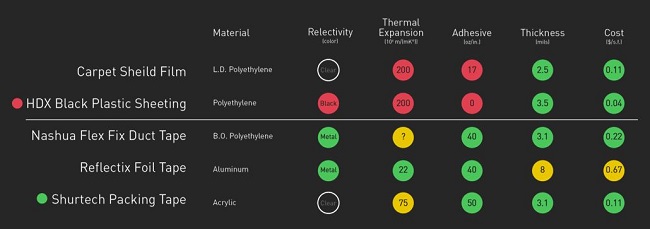 The final option was to use something like the bending bimetal surface to actuate the system. Unfortunately they don’t sell thermal bimetal at Home Depot, so I explored a few other options in creating a cheaper and more responsive alternative. They do sell a number of generic plastics such as polyethylene that have very high thermal expansion rates. By finding the right combination of a thermally expansive and non-thermally expansive plastic, with at least one being an adhesive and at least one being dark to absorb sunlight, I found that a combination of thin, black polyethylene and clear packing tape works very well as a responsive bi-plastic combination.
Prototyping
The final option was to use something like the bending bimetal surface to actuate the system. Unfortunately they don’t sell thermal bimetal at Home Depot, so I explored a few other options in creating a cheaper and more responsive alternative. They do sell a number of generic plastics such as polyethylene that have very high thermal expansion rates. By finding the right combination of a thermally expansive and non-thermally expansive plastic, with at least one being an adhesive and at least one being dark to absorb sunlight, I found that a combination of thin, black polyethylene and clear packing tape works very well as a responsive bi-plastic combination.
Prototyping
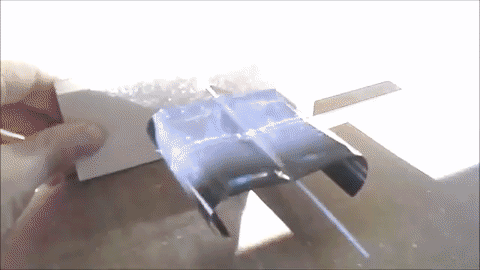 Early tests showed that this bi-plastic was very responsive to heat and sunlight. An advantage of making the bi-plastic manually is that it can be adhered flat at room temperature to make it bend when heated, or adhered on a radius at room temperature so it opens flat when heated. That gave me some much-needed design flexibility.
Early tests showed that this bi-plastic was very responsive to heat and sunlight. An advantage of making the bi-plastic manually is that it can be adhered flat at room temperature to make it bend when heated, or adhered on a radius at room temperature so it opens flat when heated. That gave me some much-needed design flexibility.
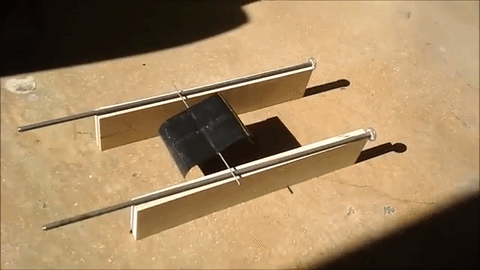 This single square of biplastic that rotates on a central axis unrolls on the sunny side, slightly shifts the center of gravity to that side, and causes the whole surface to face perpendicularly to the sun. The drawback of this simple prototype is that if there are a few of these next to each other in an array, one surface shades the one adjacent to it, preventing it from receiving sun and activating it.
This single square of biplastic that rotates on a central axis unrolls on the sunny side, slightly shifts the center of gravity to that side, and causes the whole surface to face perpendicularly to the sun. The drawback of this simple prototype is that if there are a few of these next to each other in an array, one surface shades the one adjacent to it, preventing it from receiving sun and activating it.
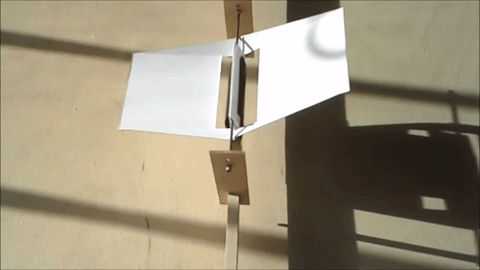 The next series used the biplastic only in the center of the panel as an actuator that pushes a static surface to face the sun.
The next series used the biplastic only in the center of the panel as an actuator that pushes a static surface to face the sun.
 This works by placing two biplastic strips opposite of each other along the frame. When the biplastic strip on the sunny side is heated, it bends towards the center, pushing the rudder of a balanced panel and causes it to rotate towards the sunny side.
Conclusions
In terms of affordability, the cost of the active plastic components is negligible compared to the metal frame it sits on. Biplastics offer a truly affordable option for fabricating thermally active components. There were some fabrication challenges with my first prototypes that relied on hand-made origami-like paper surfaces. It is surprisingly time consuming to make more than a few paper surfaces by hand. On later prototypes I used a laser-cut frame on which flat paper surfaces and rudders were attached. This was a far faster and more reliable way to mass-produce surfaces.
This works by placing two biplastic strips opposite of each other along the frame. When the biplastic strip on the sunny side is heated, it bends towards the center, pushing the rudder of a balanced panel and causes it to rotate towards the sunny side.
Conclusions
In terms of affordability, the cost of the active plastic components is negligible compared to the metal frame it sits on. Biplastics offer a truly affordable option for fabricating thermally active components. There were some fabrication challenges with my first prototypes that relied on hand-made origami-like paper surfaces. It is surprisingly time consuming to make more than a few paper surfaces by hand. On later prototypes I used a laser-cut frame on which flat paper surfaces and rudders were attached. This was a far faster and more reliable way to mass-produce surfaces.
Such a lightweight system is at the mercy of the wind unless enclosed behind glass, and the long-term durability and performance of the biplastic is still unknown. There are some trade-offs to be considered between the durability and predictability of the bimetal compared to the affordability and reactivity of the biplastic.
More posts to follow about optimizing through digital simulation, fun new design and fabrication techniques, and improved performance!